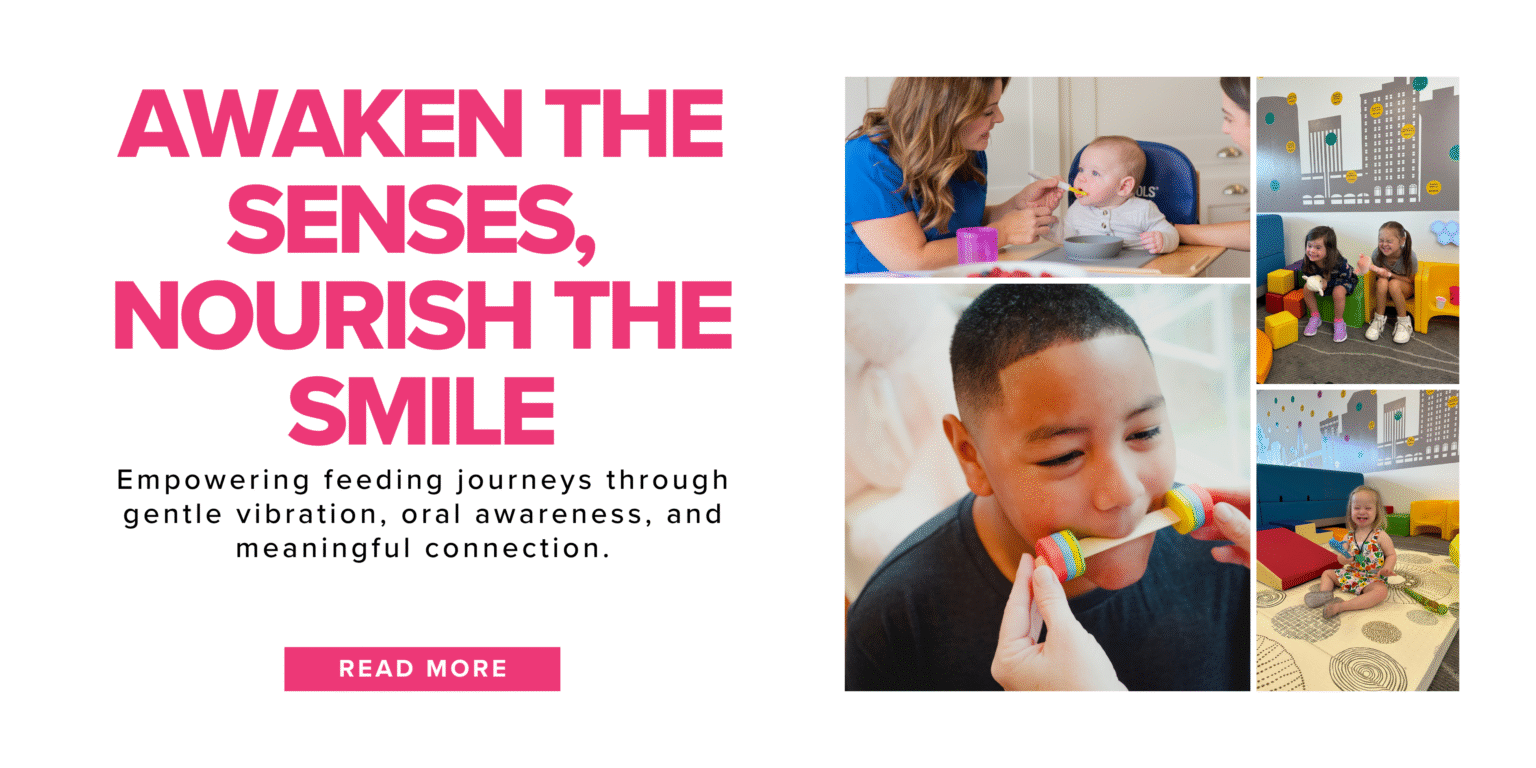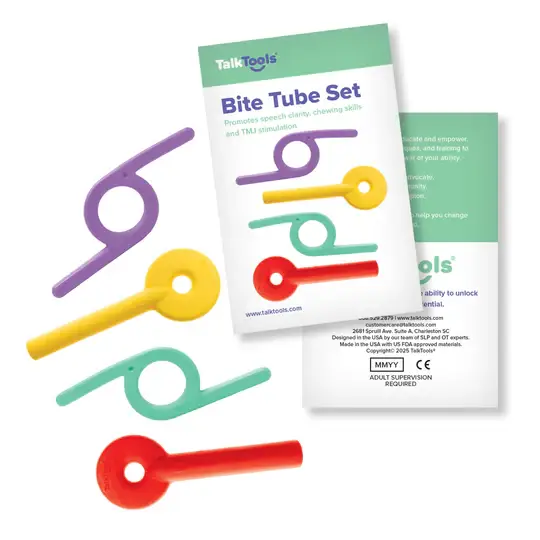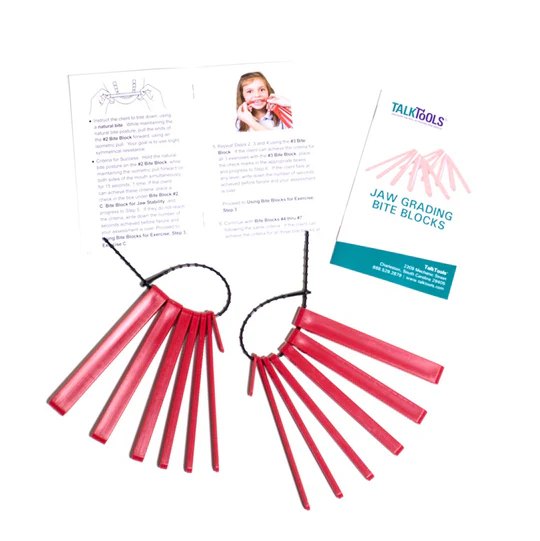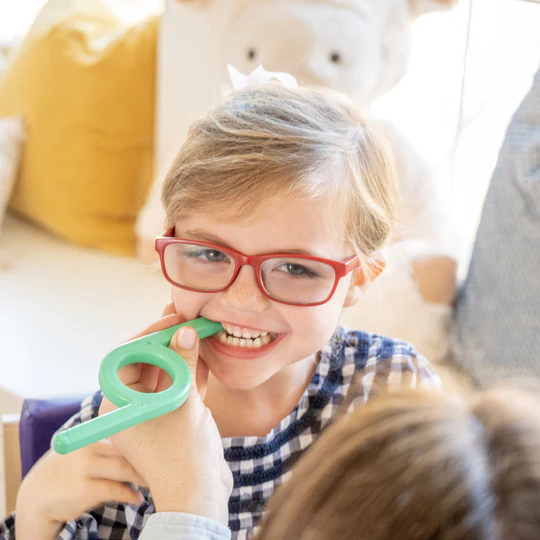If you’re working with clients who chew on their tongue or clothing, show open-mouth posture, or fatigue during chewing, TalkTools® Bite Tubes can be a game-changer. These therapist-designed tools provide targeted temporomandibular joint (TMJ) input and graded jaw work to support safer chewing and clearer speech patterns. In “Ask a Therapist,” TalkTools clinicians explain that rhythmic jaw movement can help clients self-organize and that bite tubes deliver the specific stimulus many clients are seeking—while also building jaw stability and chewing skills.
Quick take: Bite tubes = dynamic jaw grading work; bite blocks = isometric stability at set jaw heights. Use both based on your assessment.
Bite Tubes vs. Bite Blocks: What’s the difference?
Bite Tubes are used for jaw grading—the smooth, controlled opening and closing needed for chewing/mastication and co-articualtion in speech.
Bite blocks are used for isometric resistance at specific jaw positions (typically positions 2-7). They help develop stability in each discrete position.
In practice, many clinicians assess with both tools and choose the sequence based on findings such as jaw instability (open-mouth posture), limited grading, sliding, or jutting.
The TalkTools Bite Tube Color Hierarchy (and how to progress)
TalkTools’ Bite Tube Hierarchy typically follows this order: red → yellow → purple → green. A simple rule of thumb from our clinicians: once a client can achieve at least two solid compressions on a color, you can introduce the next one. Depending on the individual’s fatigue level, a session might include multiple colors in one set.
Why the colors? They help you calibrate resistance and provide a clear, motivating progression for clients and caregivers.
When bite tubes are a good fit
- TMJ stimulation for regulation: Tongue chewing, nail biting, or chewing on clothing often reflect a drive for TMJ input; bite tubes can meet that sensory need more directly than general chew tools.
- Jaw grading for feeding: Bite tubes build the dynamic control needed for safer chewing patterns.
- Jaw grading for speech: Improved control supports co-articulation for clearer speech.
- Special populations: Clinicians report use across ages, including children with low tone and adults recovering from oral cancer procedures where jaw mobility is a concern (such as trismus).
How to introduce bite tubes (therapist-led)
- Start with assessment. Screen for jaw instability, sliding, and open-mouth posture; select bite blocks and/or bite tubes accordingly.
- Choose the starting color. Begin where the client can achieve controlled compressions without compensations; then build from there.
- Set dosage and consistency. In “Ask a Therapist,” TalkTools guidance for jaw-opening work stresses consistent home practice for best outcomes (e.g., repeating assigned activities multiple times daily to build mobility and opening). Ensure any home plan matches your clinical judgment and the client’s medical status.
- Monitor fatigue and form. Progress when compressions are strong and controlled; regress if you see compensations or fatigue.
- Document and communicate. Share clear instructions with caregivers so practice stays exercise-based, not recreational chewing.
Safety notes & common pitfalls
Bite tubes are exercise tools—not all-day chewies.
Our clinicians advise using them only as directed in the program plan. For ongoing sensory needs between sessions, consider alternative sensory chew options (e.g., nubby textures) rather than the Bite Tube Hierarchy itself.
Don’t skip the assessment.
You’ll often pair bite tubes with bite blocks; the right order depends on what you see clinically.
Cue symmetrical work.
Address left/right chewing to reduce sliding or jutting; adjust color and reps to maintain good mechanics.
Case snapshots from “Ask a Therapist”
- Down syndrome & tongue chewing: TMJ-seeking behaviors (pen or shoelace chewing, tongue chewing) can respond well to the Bite Tube Hierarchy, which provides the specific masseter activation and TMJ input those clients seek—while also building jaw stability and chewing skills that support speech clarity.
- Adult trismus after oral surgery: When traditional jaw openers aren’t appropriate (e.g., due to surgical changes), clinicians report success using a combination of Bite Blocks (static opening) and Bite Tubes (dynamic mobility) to increase mobility and maintain opening—paired with high-compliance home practice.
FAQs
1. Which color should I start with?
Start where the client can achieve controlled compressions without compensations; progress color-by-color once they can get at least two strong compressions.
2. How is this different from general chew tools?
General chew tools can soothe, but bite tubes deliver targeted TMJ and jaw-grading work for chewing and co-articulation goals, following a structured hierarchy.
3. Do I use bite tubes all day to curb chewing on clothes?
No—use them only as prescribed exercises. For ongoing sensory needs, choose separate chew options (e.g., nubby textures).
4. Can bite tubes be used with bite blocks?
Yes. Many clinicians assess with both and then deploy bite blocks for stability and bite tubes for dynamic grading—often in the same plan.






